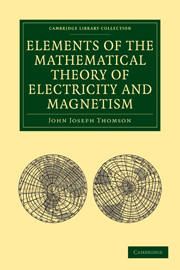Book contents
- Frontmatter
- PREFACE TO FIRST EDITION
- PREFACE TO THE SECOND EDITION
- PREFACE TO THE THIRD EDITION
- PREFACE TO THE FOURTH EDITION
- Contents
- CHAP. I General Principles of Electrostatics
- CHAP. II Lines of Force
- CHAP. III Capacity of Conductors. Condensers
- CHAP. IV Specific Inductive Capacity
- CHAP. V Electrical Images and Inversion
- CHAP. VI Magnetism
- CHAP. VII Terrestrial Magnetism
- CHAP. VIII Magnetic Induction
- CHAP. IX Electric Currents
- CHAP. X Magnetic Force due to Currents
- CHAP. XI Electromagnetic Induction
- CHAP. XII Electrical Units: Dimensions of Electrical Quantities
- CHAP. XIII Dielectric Currents and the Electromagnetic Theory of Light
- CHAP. XIV Thermoelectric Currents
- CHAP. XV The Properties of Moving Electric Charges
- INDEX
CHAP. VIII - Magnetic Induction
Published online by Cambridge University Press: 07 September 2010
- Frontmatter
- PREFACE TO FIRST EDITION
- PREFACE TO THE SECOND EDITION
- PREFACE TO THE THIRD EDITION
- PREFACE TO THE FOURTH EDITION
- Contents
- CHAP. I General Principles of Electrostatics
- CHAP. II Lines of Force
- CHAP. III Capacity of Conductors. Condensers
- CHAP. IV Specific Inductive Capacity
- CHAP. V Electrical Images and Inversion
- CHAP. VI Magnetism
- CHAP. VII Terrestrial Magnetism
- CHAP. VIII Magnetic Induction
- CHAP. IX Electric Currents
- CHAP. X Magnetic Force due to Currents
- CHAP. XI Electromagnetic Induction
- CHAP. XII Electrical Units: Dimensions of Electrical Quantities
- CHAP. XIII Dielectric Currents and the Electromagnetic Theory of Light
- CHAP. XIV Thermoelectric Currents
- CHAP. XV The Properties of Moving Electric Charges
- INDEX
Summary
152. When a piece of unmagnetized iron is placed in a magnetic field it becomes a magnet, and is able to attract iron filings; it is then said to be magnetized by induction. Thus if a piece of soft iron (a common nail for example) is placed against a magnet, it becomes magnetized by induction, and is able to support another nail, while this nail can support another one, and so on until a long string of nails may be supported by the magnet.
If the positive pole of a bar magnet be brought near to one end of a piece of soft iron, that end will become charged with negative magnetism, while the remote end of the piece of iron will be charged with positive magnetism. Thus the opposite poles of these two magnets are nearest each other, and there will therefore be an attraction between them, so that the piece of iron, if free to move, will move towards the inducing magnet, i.e. it will move from the weak to the strong parts of the magnetic field due to this magnet. If, instead of iron, pieces of nickel or cobalt are used they will tend to move in the same way as the iron, though not to so great an extent.
- Type
- Chapter
- Information
- Elements of the Mathematical Theory of Electricity and Magnetism , pp. 246 - 282Publisher: Cambridge University PressPrint publication year: 2009First published in: 1895

